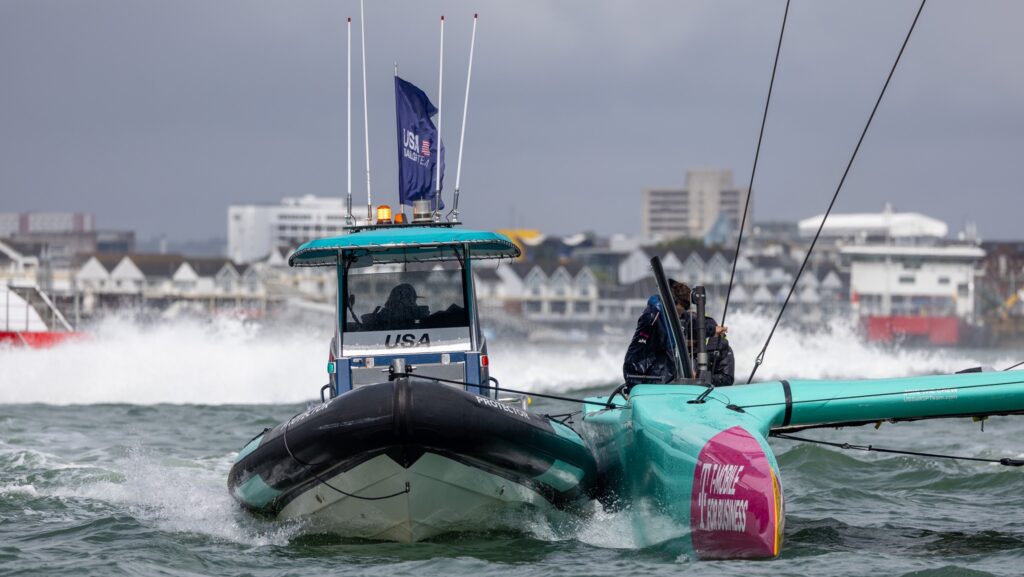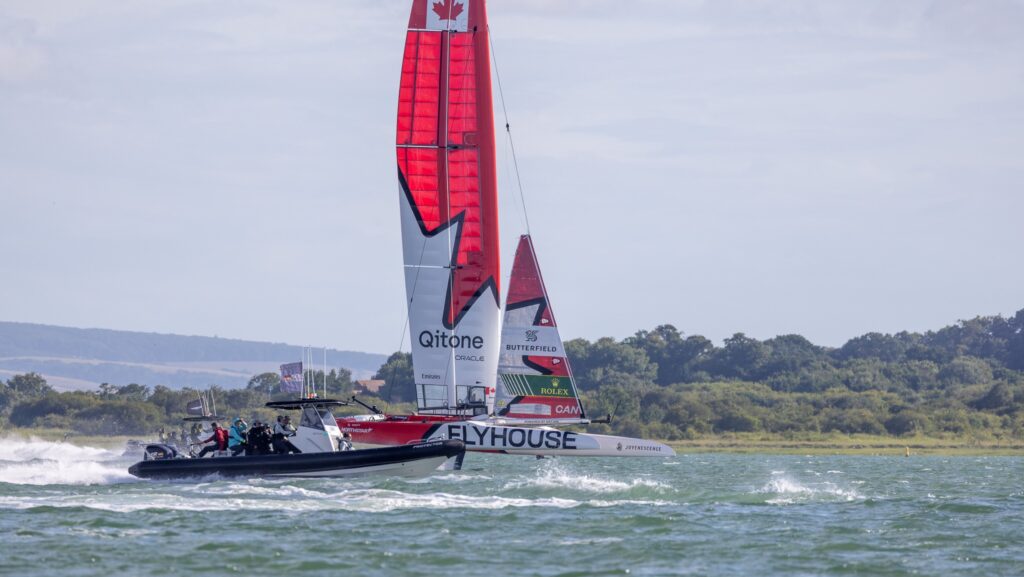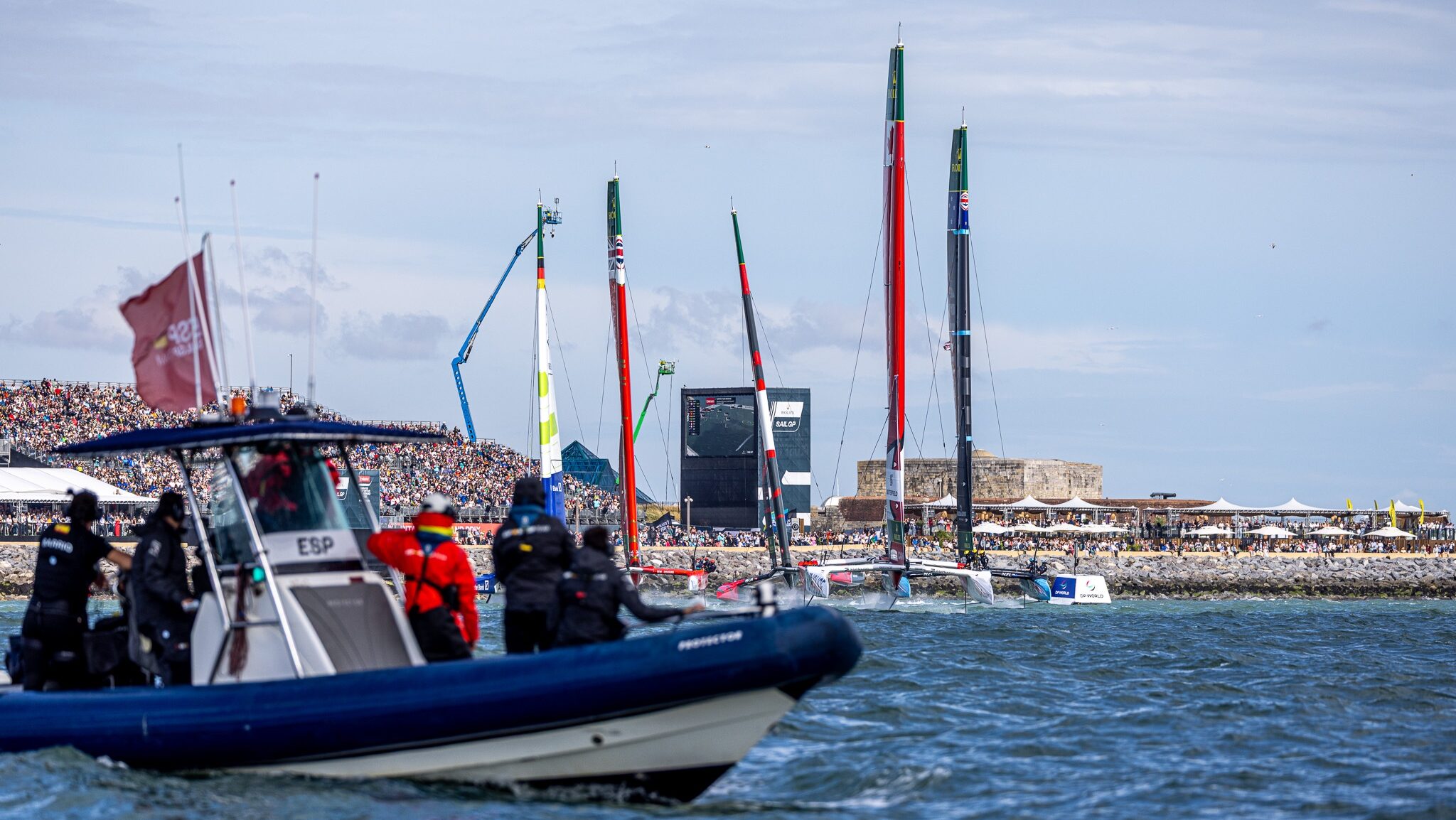“A chase boat is not just a tender, it’s the nerve centre for the team on the water,” says Andy Andrews of Protector Boats. “It keeps coaches close enough to observe performance, provides a safety net in the event of gear failure, and often doubles up as a logistics hub, a media platform, or even a rescue vessel. That versatility is why it must be designed and specified to an incredibly high standard.”
Protector Boats has been producing RIBs from its base in New Zealand since the mid-1990s. And anyone who’s been to watch SailGP in action has likely witnessed one of the company’s chase boats in action. The images above and below show the recent Portsmouth iteration.
Andrews’ career spans leisure and commercial RIB supply, search and rescue boat development, and specialist support for elite race teams. Now he’s European representative for New Zealand’s Protector Boats through PB Europe (part of the Ancasta Group). He recently told MIN that globally maritime enforcement and operational agencies are rethinking the long-established model of maintaining multiple specialist vessels – each dedicated to a single role – and that they’re being replaced by a preference for multi-role platforms capable of tackling a range of assignments without sacrificing performance.

Now he says good chase boats combine speed, reliability, and – crucially – adaptability. They need to match the performance of the race yacht they’re supporting, and carry crew, spares, tools, and (sometimes) additional sails. Operational demands are the determining factor for chase boats, but common characteristics make a chase boat truly fit for purpose.
While there are many high-performance RIBs capable of achieving the speed required to keep up with the world’s fastest yachts, very few can maintain a stable working platform at high speeds and in challenging sea states, Andrews believes. That’s a critical factor when crews are filming yacht performance or using laptops to analyse real-time performance data.
This is where he says Protector – the company he’s been with for over two years – stands out. Its boats deliver a stable and reliable platform that allows shore teams to continue their duties without compromise.
Providing the key is “the Deep V Hull and layup of the GRP.
“Most RIB/boat hulls have a layup of 10-12 mm, but the Protector has nearly double that and this provides a solid hull that can withstand the impact of heavy seas at speed.”
Another important – yet often underestimated – requirement is transportability. For teams competing in worldwide circuits like SailGP, moving chase boats around the globe is a logistical challenge.
“Easy shipping in a standard container is imperative. If your chase boat can’t be packed down and shipped cost-effectively, then your international campaign instantly becomes far more expensive and complicated.”
Protector designs have evolved over 30 years to meet ever increasing demands, like transport.
“After an event, the Protector Chase 330 can be packed down in just a couple of hours: once the boat is placed on a cradle, tubes deflated and Bimini removed, it slides straight into a standard 40ft shipping container. And it’s just as quickly reassembled and back on the water, ready for action once it arrives at the next regatta.”

Developing chase boats to suit client requirements
The way the company works directly with race teams and commercial users to understand their operational requirements – on and off the water – has made all the difference to the development of the RIBs.
Flexibility is paramount. Users may be looking for crew transfers or media filming or any one of half a dozen roles in a single day. Each team’s individual specifications need to be assessed.
“By sitting down with the owners and shore crews, we can design flexible deck arrangements that support multiple activities. We produce detailed renders so teams can see how the options will work in practice. It’s about listening, then delivering exactly what they need.
“Without being able to name individuals, one race team owner wanted a chase boat for his race team, however as his team only participated in six events per year, he also wanted a chase boat that would double up as family leisure boat. That required us to create a deck plan and specification that worked for both roles.”
Among Protector’s menu of solutions to work with (making one boat adaptable for many uses – mirroring maritime enforcement customers’ desires) are stainless steel deck tie points for securing sails and gear, extended Bimini shades, and uprated tow posts for handling high-performance yachts.
Plus, Andrews says because, “each team has its own preference of electronics, the flexibility and capability of the Protector technicians to install the electronics of choice for each team, from navigation to communications means enhanced electronics packages for data gathering and communication are offered.”
Turning point for Protector’s chase boats during America’s Cup
Protector’s credentials are not theoretical, notes Andrews. The company’s boats have been proven in the toughest race environments for over two decades.
The turning point came in the year 2000, when the America’s Cup was held in Auckland. Protector RIBs established itself as the preferred chase boat, favoured for its rough-water handling and ability to pull alongside yachts without causing damage. Smaller teams who couldn’t buy one, rented on instead. Since then, Protectors have remained a staple of the America’s Cup.
“In the last AC in Barcelona there were a total of 28 Protectors spread across the teams – most teams having a minimum of four chase Protectors. Most teams also have one on-water co-ordination boat which is usually a Catalyst twin hulled RIB built in NZ.
“There are a few other brands of boat used by teams for other tasks such as coaching and media. For example Scorpions, and SeaRIBs. Each team also had to have the much publicised Hydrogen Powered Chase Boat to promote event environmental sustainability,” says Andrews.
Like a world-class race team, chase boats need preparation, precision, and the ability to adapt. By combining commercial-grade reliability with custom specification, teams have the tools they need to focus on winning races – confident that their support craft won’t let them down.
“Every chase boat we deliver is about enabling performance at the highest level,” Andrews concludes. “When a team knows their support boat is completely fit for purpose that’s when they can focus 100 per cent on racing. That’s what makes the difference.”
The post The key requirement for world-class race support in chase boats? Flexibility appeared first on Marine Industry News.

Leave a Reply